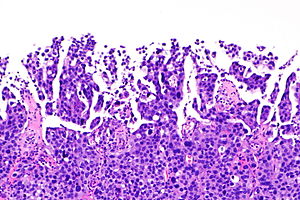Difference between revisions of "Micropapillary urothelial carcinoma"
Jump to navigation
Jump to search
| Line 46: | Line 46: | ||
**Quantity of micropapillary pattern (percentage) is variable.<ref name=pmid25673582/> | **Quantity of micropapillary pattern (percentage) is variable.<ref name=pmid25673582/> | ||
*Conventional [[urothelial carcinoma]] (typical). | *Conventional [[urothelial carcinoma]] (typical). | ||
Note: | |||
*In other organs, [[adenocarcinoma]] would be in the differential diagnosis. It should be noted that [[adenocarcinoma of the urinary bladder]] looks quite different than ''micropapillary urothelial carcinoma''. | |||
DDx: | DDx: | ||
Revision as of 21:14, 5 July 2016
| Micropapillary urothelial carcinoma | |
|---|---|
| Diagnosis in short | |
 Urothelial carcinoma with micropapillary features. H&E stain. | |
| Subtypes | (subtype of urothelial carcinoma) |
| LM DDx | conventional urothelial carcinoma, other micropapillary carcinomas (metastases) |
| IHC | CK7 +ve, CK20 +ve/-ve, GATA3 +ve, p63 -ve/+ve |
| Grossing notes | radical cystectomy grossing, cystoprostatectomy grossing, nephroureterectomy grossing |
| Staging | bladder cancer staging |
| Site | urothelium - urinary bladder, ureter, renal pelvis, urethra (males) |
|
| |
| Signs | hematuria (typical presentation) |
| Prevalence | rare |
| Prognosis | poor (aggressive course) |
| Treatment | cystectomy/cytoprostatectomy - advocated for cT1 disease by some |
Micropapillary urothelial carcinoma (abbreviated MPUC), also micropapillary urothelial cell carcinoma (abbreviated MPUCC), is an aggressive variant of urothelial carcinoma.[1]
General
Treatment:
- cT1 disease treated by radical cystectomy in some centres.[3]
Microscopic
Features:[1]
- Micropapillae - definitional.
- Nipple-like structures without fibrovascular cores.
- Quantity of micropapillary pattern (percentage) is variable.[2]
- Conventional urothelial carcinoma (typical).
Note:
- In other organs, adenocarcinoma would be in the differential diagnosis. It should be noted that adenocarcinoma of the urinary bladder looks quite different than micropapillary urothelial carcinoma.
DDx:
- Metastasis (breast, ovary, lung, pancreas, salivary gland).
Images
Case 1
Case 2
www
IHC
Features:
Others:[4]
- p63 -ve/+ve.
- p40 -ve/+ve.
Sign out
- Report percentage of micropapillary pattern - suggested.[citation needed]
See also
References
- ↑ 1.0 1.1 1.2 Compérat, E.; Roupret, M.; Yaxley, J.; Reynolds, J.; Varinot, J.; Ouzaïd, I.; Cussenot, O.; Samaratunga, H. (Dec 2010). "Micropapillary urothelial carcinoma of the urinary bladder: a clinicopathological analysis of 72 cases.". Pathology 42 (7): 650-4. doi:10.3109/00313025.2010.522173. PMID 21080874.
- ↑ 2.0 2.1 2.2 2.3 2.4 2.5 2.6 Chatterjee, D.; Das, A.; Radotra, BD.. "Invasive micropapillary carcinoma of urinary bladder: a clinicopathological study.". Indian J Pathol Microbiol 58 (1): 2-6. doi:10.4103/0377-4929.151153. PMID 25673582.
- ↑ Willis, DL.; Fernandez, MI.; Dickstein, RJ.; Parikh, S.; Shah, JB.; Pisters, LL.; Guo, CC.; Henderson, S. et al. (Apr 2015). "Clinical outcomes of cT1 micropapillary bladder cancer.". J Urol 193 (4): 1129-34. doi:10.1016/j.juro.2014.09.092. PMID 25254936.
- ↑ 4.0 4.1 Lin, X.; Zhu, B.; Villa, C.; Zhong, M.; Kundu, S.; Rohan, SM.; Yang, XJ. (Sep 2014). "The utility of p63, p40, and GATA-binding protein 3 immunohistochemistry in diagnosing micropapillary urothelial carcinoma.". Hum Pathol 45 (9): 1824-9. doi:10.1016/j.humpath.2014.04.015. PMID 24993315.










